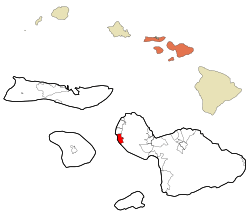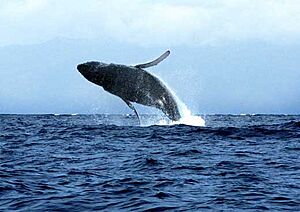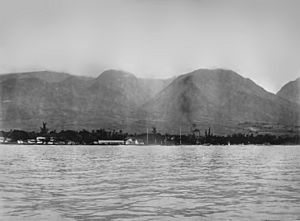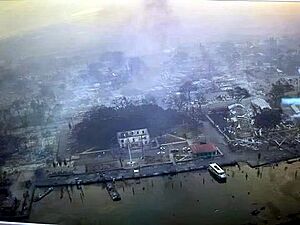Lahaina, Hawaii facts for kids
Quick facts for kids
Lahaina, Hawaii
Lāhainā
Lele
|
|
|---|---|

Downtown Lahaina on the waterfront prior to the 2023 fire
|
|

Location in Maui County and the state of Hawaii
|
|
| Country | United States |
| State | Hawaii |
| County | Maui |
| Area | |
| • Total | 9.29 sq mi (24.07 km2) |
| • Land | 7.78 sq mi (20.15 km2) |
| • Water | 1.51 sq mi (3.92 km2) |
| Elevation | 3 ft (1 m) |
| Population
(2020)
|
|
| • Total | 12,702 |
| • Density | 1,632/sq mi (630.2/km2) |
| Time zone | UTC-10 (Hawaii-Aleutian) |
| ZIP Codes |
96761, 96767
|
| Area code(s) | 808 |
| FIPS code | 15-42950 |
| GNIS feature ID | 0361678 |
Lahaina is a town located in Maui County, Hawaii, United States. It's on the northwest coast of the island of Maui. This area includes Lahaina town itself, along with the beautiful Kaanapali and Kapalua beach resorts.
In 2020, before the terrible wildfires, Lahaina had a population of 12,702 people. The town stretches along Hawaii Route 30, from a tunnel in the south, through Olowalu, up to the areas of Kaanapali and Napili-Honokowai in the north.
Sadly, in August 2023, a series of wildfires destroyed about 80% of Lahaina. This tragic event caused the deaths of 102 people.
Contents
History of Lahaina
What's in a Name?
How Lahaina Got Its Name
Protestant missionaries arrived in Hawaii between 1820 and 1826. They helped create a way to write the Hawaiian language using English letters. The name Lahaina comes from two Hawaiian words: "lā" meaning sun, and "hainā" meaning cruel. So, Lahaina means "cruel sun." This name might have come from a story about a chief who was annoyed by the hot sun in Kauaula Valley.
Lahaina was originally called Lele in the Hawaiian language. Lele means jump or fly. The area was also known for its many breadfruit trees.
Old Hawaiian Rulers
The first supreme ruler of western Maui was Haho. Later, during the rule of Kakaʻalaneo, the name Lele was used. Kakaʻalaneo was the first to plant breadfruit trees in the area.
A powerful ruler named Piʻilani was the first to unite the entire island of Maui under his control. He also ruled the nearby islands of Lānaʻi, Kahoʻolawe, and parts of Molokaʻi.
Early Visitors and Changes
Meeting Captain Cook
On November 26, 1778, Captain James Cook's ships appeared near Maui. He didn't land, but Hawaiian warriors, including a young Kamehameha I, greeted him in their canoes. A famous statue of Kamehameha I in Honolulu shows this meeting off the coast of Lahaina.
The Reign of Kamehameha I and II
From 1802 to 1803, Kamehameha I kept his large fleet of war-canoes in Lahaina. He worked to unite all the Hawaiian Islands. In 1810, the last independent ruler of Kauaʻi surrendered, finally uniting the islands. Kamehameha II also lived in Lahaina for a short time from 1819 to 1820.
Christian Missionaries Arrive
American Protestant missionaries came to Hawaii in 1820. The first mission on Maui was set up in Lahaina in 1823 by Reverend Charles Stewart and William Richards. They taught Queen Keōpūolani, the wife of Kamehameha I, about Christianity.
In 1824, Betsey Stockton started the first school in Lahaina for common people. A stone church, the Waiola Church, was started in 1828. In 1831, missionaries founded Lahainaluna Seminary (now Lahainaluna High School). Here, Hawaiian boys learned about religion and skills like carpentry and printing. This school even published Hawaii's first Hawaiian language newspaper in 1834.
Whaling Ships and Conflicts
Lahaina became a very important stop for whaling ships in the 1800s. Whalers would stop there to get fresh water, food, and other supplies. The sailors often caused trouble, leading to conflicts with the local missionaries. In 1827, a British whaling ship even fired cannons at Lahaina! Because of this, Governor Hoapili built the Old Lahaina Fort in 1831 to protect the town from rowdy sailors.
Kamehameha III and the Capital Move
Kamehameha III lived in Lahaina from 1837 to 1845. He lived in a royal compound on the sacred island of Mokuʻula in the middle of Mokuhinia lake. In 1840, he signed the first Hawaiian constitution in Lahaina. The first meeting of the Hawaiian legislature also took place here in 1841.
However, as Honolulu on Oʻahu became more important for trade, Kamehameha III moved the capital there in 1845. The royal palace in Lahaina later became a courthouse.
A famous banyan tree was planted in Lahaina on April 24, 1873. It was planted to celebrate 50 years since the Christian missionaries arrived. This tree grew to be the largest banyan tree in the United States.
21st Century and the Wildfires
On August 8–9, 2023, a major wildfire swept through Lahaina. Strong winds from Hurricane Dora and dry conditions made the fire spread quickly. Most of Lahaina was destroyed, and 102 people lost their lives.
Geography and Climate
Lahaina is a town with a total area of about 9.3 square miles (24.1 square kilometers). Most of this area is land, with some water.
Lahaina's Climate
Lahaina town is one of the driest places in Hawaii. This is because it's in the "rain shadow" of the Mauna Kahālāwai, also known as the West Maui Mountains. This means the mountains block the rain clouds.
However, different parts of Lahaina have different climates. For example, Kaanapali, which is north of Lahaina town, gets twice as much rain and has frequent breezes. Kapalua and Napili get almost four times more rain than Lahaina town.
Lahaina has a hot, semi-arid climate. This means it has warm temperatures all year round, with some rain in the winter and very dry summers.
| Climate data for Lahaina, Maui | |||||||||||||
|---|---|---|---|---|---|---|---|---|---|---|---|---|---|
| Month | Jan | Feb | Mar | Apr | May | Jun | Jul | Aug | Sep | Oct | Nov | Dec | Year |
| Record high °F (°C) | 89 (32) |
89 (32) |
91 (33) |
89 (32) |
91 (33) |
93 (34) |
93 (34) |
97 (36) |
94 (34) |
94 (34) |
92 (33) |
91 (33) |
97 (36) |
| Mean daily maximum °F (°C) | 82 (28) |
82 (28) |
83 (28) |
84 (29) |
84 (29) |
86 (30) |
87 (31) |
88 (31) |
88 (31) |
87 (31) |
85 (29) |
83 (28) |
85 (29) |
| Mean daily minimum °F (°C) | 64 (18) |
64 (18) |
65 (18) |
66 (19) |
67 (19) |
69 (21) |
70 (21) |
71 (22) |
71 (22) |
70 (21) |
68 (20) |
66 (19) |
68 (20) |
| Record low °F (°C) | 54 (12) |
53 (12) |
54 (12) |
54 (12) |
57 (14) |
60 (16) |
62 (17) |
63 (17) |
61 (16) |
58 (14) |
56 (13) |
52 (11) |
52 (11) |
| Average rainfall inches (mm) | 3.15 (80) |
2.04 (52) |
1.83 (46) |
0.74 (19) |
0.44 (11) |
0.08 (2.0) |
0.14 (3.6) |
0.28 (7.1) |
0.31 (7.9) |
0.89 (23) |
1.83 (46) |
2.90 (74) |
14.63 (371.6) |
| Source: The Weather Channel | |||||||||||||
People of Lahaina
| Historical population | |||
|---|---|---|---|
| Census | Pop. | %± | |
| 1980 | 6,654 | — | |
| 1990 | 9,189 | 38.1% | |
| 2000 | 9,118 | −0.8% | |
| 2010 | 11,704 | 28.4% | |
| 2020 | 12,702 | 8.5% | |
| U.S. Decennial Census | |||
In 2020, Lahaina had a population of 12,702 people. The population is made up of many different groups. About 34.8% were Asian, 27.9% were White, and 10.5% were Native Hawaiian and other Pacific Islanders. Many people were also from two or more races. About 11.5% of the population identified as Hispanic or Latino.
Fun Things to See and Do
Before the 2023 fire, Front Street in Lahaina was a very popular place. It had many stores and restaurants and was the center of the Lahaina Historic District. This historic area included 60 important sites. The Banyan Court Park was home to the largest banyan tree in the United States. This huge tree was 60 feet (18 meters) tall and had 46 extra trunks, covering an area almost as big as two football fields!
Near the harbor, you could find the historic Pioneer Inn and the Baldwin House, a landmark built in the 1800s.

Watching whales was a very popular activity in Lahaina. You could often see humpback whales, and sometimes even other types like fin whales or blue whales.
The Carthaginian II was a museum ship docked in Lahaina's harbor. It was built in 1920 and became a whaling museum in 1973. In 2005, it was sunk offshore to create an artificial reef for sea life.
Hale Paʻi, located at Lahainaluna High School, was the site of Hawaii's first printing press. Hawaii's first paper money was printed here in 1843. The "L" on the West Maui mountains stands for Lahainaluna High School, which was built in 1904.
Halloween was a huge celebration in Lahaina, attracting thousands of people. Front Street would be closed to cars, and there would be a "Keiki Parade" for children in costumes. Adults also dressed up, and Halloween night in Lahaina was sometimes called the "Mardi Gras of the Pacific."
Sports in Lahaina
Each November, the Lahaina Civic Center usually hosts the Maui Invitational. This is a big early-season college basketball tournament. However, the 2023 tournament had to be moved to Honolulu because of the wildfires.
The Lahaina Aquatic Center is a place for swim meets and water polo games. Tennis events also happen here.
Lahaina is also the finish line for the Victoria to Maui Yacht Race. This race starts in Victoria, British Columbia, Canada, and happens every two years.
The Plantation Course at Kapalua hosts the PGA Tour's Sentry Tournament of Champions every January.
Images for kids
See also
 In Spanish: Lahaina para niños
In Spanish: Lahaina para niños










